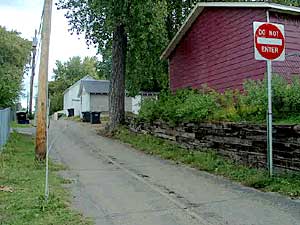|
Audio
Photos
Resources
Your Voice
|
Report: City housing policies create 'lethal agenda'
September 19, 2003
 |
| Report authors say one of the problems with low-density housing in the inner cities, is that the space in between and behind houses can conceal criminal activity. (MPR Photo/Brandt Williams) |
Minneapolis, Minn. — Steve Belmont is an architect and a member of the Great Cities Alliance,a new non-profit urban planning policy advocacy group. He based his report on research he conducted in 30 U.S. cities for a book on the state of urban centers around the country.
Belmont, like elected officials, says stopping crime requires a combination of law enforcement and economic revitalization. However, Belmont says for the most part, the city is following outdated policies in troubled neighborhoods.
 | |||
"First of all, get rid of the obsolete zoning classification detached house zoning," Belmont says. "That made sense in the 1950s. It doesn't make sense anymore. Detached house zoning as kind of low-density, residential development at the heart of a vastly expanded post-industrial metropolis no longer makes planning sense. It's unsustainable."
In layman's terms, Belmont believes the city needs to alter its policies to encourage the development of more townhouses and apartment buildings in neighborhoods dominated by single-family homes. He says economic development can only happen when there are enough people living in an area to support neighborhood businesses and mass transit.
However, Belmont says the majority of that housing should be priced at market rates, to break up concentrations of poverty. He says there's a persistent link between poverty and crime.
"You couple that with the fact there's a renewed interest in this precious land at the heart of the metropolis, renewed interest on the part of middle class households -- we should take advantage of the opportunity to disperse poverty in a meaningful way," Belmont says.
Minneapolis Mayor R.T. Rybak says the city has focused on making the city livable for people of all incomes, rather than dispersing poverty. And he says the city is striving to increase housing density.
 | |||
"Minneapolis at its peak had half a million people, and today it has only 385,000 people," says Rybak. "We have room for more people, especially if we focus them along transit corridors. We agree with what the report says, but the report unfortunately didn't recognize the fact that we've delivered on that promise, and we're going to keep working harder on that."
Rybak says there are several examples of high crime areas that have been improved by housing development. He says the Elliot Park neighborhood has benefitted from East Village, a $29.5 million housing development. The project combines 180 mixed income housing units with commercial retail space.
"High density can be acheived. It can be attractive," says Ed Goetz. "It can be something people demand in the marketplace."
Goetz is a professor at the University of Minnesota's Center for Urban and Regional Affairs. He is also the author of Clearing the Way: Deconcentrating the Poor in Urban America. He agrees Minneapolis needs to increase density, but he says it will only happen in certain parts of the city, like downtown or along established commercial corridors. Goetz says increasing the density of residential areas of the city will be much harder because of the high number of single family homes.
"To alter that in the ways that he (Belmont) would like to see would take an enormous change in the mindset of people living here, in the mindset of public officials, and also an enormous change in the physical landscape," says Goetz.
Study author Steve Belmont acknowledges the density and population of Minneapolis are growing gradually. But so gradually, he says it might take more than 100 years for the city to reach its potential.
|
News Headlines
|
Related Subjects
|
